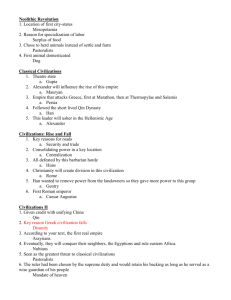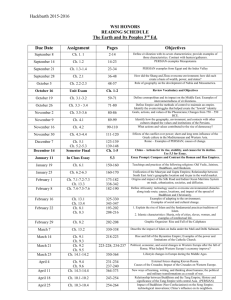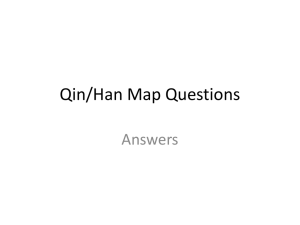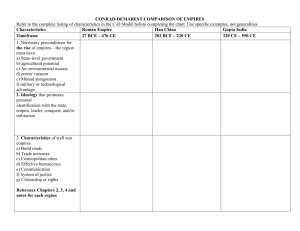China PERSIAN Chart for Classical Civilizations Key ERA: 600
advertisement
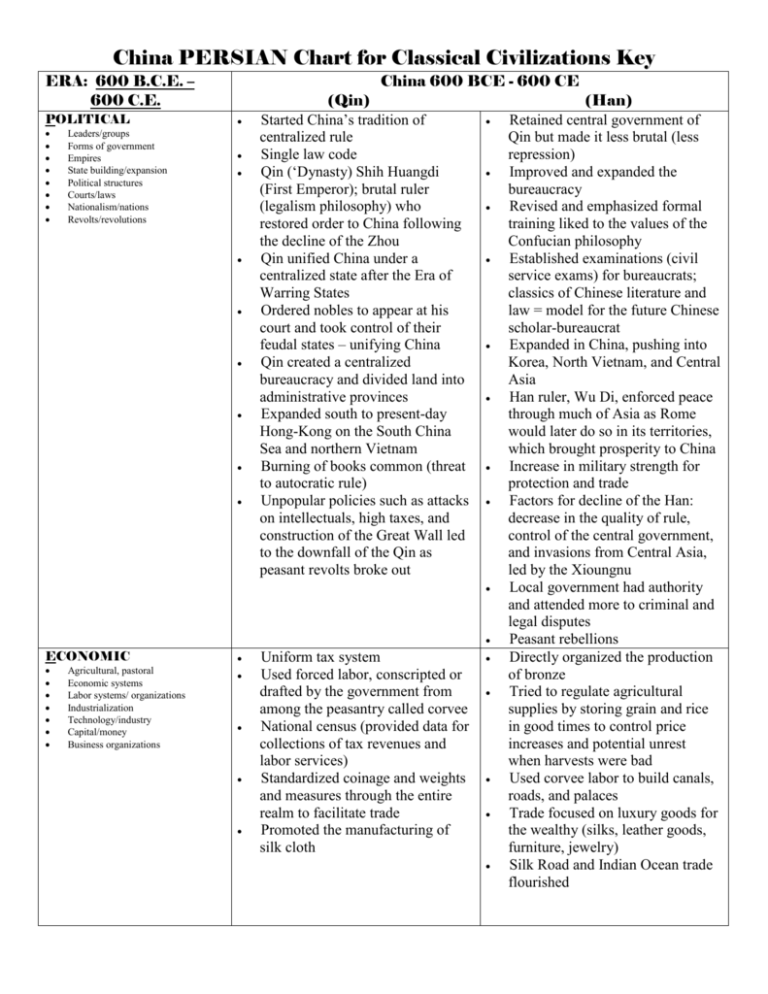
China PERSIAN Chart for Classical Civilizations Key ERA: 600 B.C.E. – 600 C.E. POLITICAL Leaders/groups Forms of government Empires State building/expansion Political structures Courts/laws Nationalism/nations Revolts/revolutions China 600 BCE - 600 CE (Qin) Started China’s tradition of centralized rule Single law code Qin (‘Dynasty) Shih Huangdi (First Emperor); brutal ruler (legalism philosophy) who restored order to China following the decline of the Zhou Qin unified China under a centralized state after the Era of Warring States Ordered nobles to appear at his court and took control of their feudal states – unifying China Qin created a centralized bureaucracy and divided land into administrative provinces Expanded south to present-day Hong-Kong on the South China Sea and northern Vietnam Burning of books common (threat to autocratic rule) Unpopular policies such as attacks on intellectuals, high taxes, and construction of the Great Wall led to the downfall of the Qin as peasant revolts broke out ECONOMIC Agricultural, pastoral Economic systems Labor systems/ organizations Industrialization Technology/industry Capital/money Business organizations Uniform tax system Used forced labor, conscripted or drafted by the government from among the peasantry called corvee National census (provided data for collections of tax revenues and labor services) Standardized coinage and weights and measures through the entire realm to facilitate trade Promoted the manufacturing of silk cloth (Han) Retained central government of Qin but made it less brutal (less repression) Improved and expanded the bureaucracy Revised and emphasized formal training liked to the values of the Confucian philosophy Established examinations (civil service exams) for bureaucrats; classics of Chinese literature and law = model for the future Chinese scholar-bureaucrat Expanded in China, pushing into Korea, North Vietnam, and Central Asia Han ruler, Wu Di, enforced peace through much of Asia as Rome would later do so in its territories, which brought prosperity to China Increase in military strength for protection and trade Factors for decline of the Han: decrease in the quality of rule, control of the central government, and invasions from Central Asia, led by the Xioungnu Local government had authority and attended more to criminal and legal disputes Peasant rebellions Directly organized the production of bronze Tried to regulate agricultural supplies by storing grain and rice in good times to control price increases and potential unrest when harvests were bad Used corvee labor to build canals, roads, and palaces Trade focused on luxury goods for the wealthy (silks, leather goods, furniture, jewelry) Silk Road and Indian Ocean trade flourished China PERSIAN Chart for Classical Civilizations Key RELIGIOUS Belief systems/ teachings Philosophy Holy books Conversion Key figures Deities Practiced the philosophy of Legalism SOCIAL Family/ kinship Gender roles/relations Social and economic classes Racial/ ethnic factors Entertainment Lifestyles “Haves” & “have nots” Burnt Confucian books and buried scholars alive Patriarchal society INTERACTIONS War/conflict Diplomacy/treaties Alliances Exchanges between individuals, groups, & empires/nations Trade/commerce Globalization Built the Great Wall of China to protect against invaders Promoted Confucian philosophy as an official statement of Chinese values Government developed a durable sense of mission as the primary keeper of Chinese beliefs. Daoism and the reverence for nature became a central value of Han people Buddhism became widely popular during the fall of the Han Empire Created a large, highly-skilled bureaucracy – scholar-bureaucrats (scholar-gentry) Men of exceptional talent and ability trained in schools of merit for civil service exams – traditionally from the upperclasses (who had time to study) but occasionally allowed individuals from lower ranks of society Landowning aristocracy/ educated bureaucrats (Mandarins) Laboring masses (peasants, urban artisans) “Mean” people (included performing artists) Merchant class was not a focal point; a life dedicated to making money was scorned by society Emphasized the role and importance of family unity – filial piety Patriarchal society Emphasis on Confucian relationships Women were clearly defined subordinate roles; could sometimes gain power through their sons Silk Road trade flourished from Chang’an to the Roman Empire – It connected the Han Empire to Central Asia, India, and the Roman Empire Tributary system of trade was established – Han demanded tributes from neighboring groups. Han often sent gifts to nomadic groups to prevent possible invasion China PERSIAN Chart for Classical Civilizations Key ARTS Art / Music Writing/ Literature Philosophy Math / Science Education Architecture Technology/ Innovations Transportation Great Wall of China Road planning Uniform writing system (Chinese script) = single basic language ENVIRONMENTAL Location Physical Human/environment Migration/movement Region Demography Neighborhood Settlement patterns Disease Urbanization/ cities (2 major) Sponsored public works such as new irrigation projects and canal systems for agriculture Schools and universities based on merit; priority on education in upper classes Invented a kind of seismography to register earthquakes Collar invented for draft animals (horses and oxen), allowing them to pull wagons and plows without choking Pulleys and winding gear were used in mining, which brought materials to the surface 1st water powered mills Invention of paper allowed from more written works Iron tools Better production methods in textiles and pottery Sternpost rudder and compass aided sea travel Expansion as the empire grew; contraction as the empire was attacked by the nomadic invaders and by peasant revolts Chang’an – capitol city flourished from trade. Guangzhou – port city for Indian Ocean trade (silk Roads Sea Lane) China PERSIAN Chart for Classical Civilizations Key ERA: 600 B.C.E. – 600 C.E. POLITICAL Leaders/groups Forms of government Empires State building/expansion Political structures Courts/laws Nationalism/nations Revolts/revolutions India ECONOMIC Agricultural, pastoral Economic systems Labor systems/ organizations Industrialization Technology/industry Capital/money Business organizations Ashoka encouraged agricultural development through irrigation and encouraged trade by building roads, wells, and inns RELIGIOUS Belief systems/ teachings Philosophy Holy books Conversion Key figures Deities (Mauryans) Regionalism – led by autocratic kings and emperors – Decentralized Chandragupta founder of Mauryan Empire – centralized control of the regional kingdoms Maurya set up a centralized bureaucratic administrative system Ashoka – converted to Buddhism Buddhism Saddartha Gautama - Buddha – “Enlightened One” (seen as divine) Holy life could be achieved through individual effort from any level of society. Goal to reach Nirvana through meditation Encouraged missionaries Reincarnation Dharma and Karma SOCIAL Family/ kinship Gender roles/relations Social and economic classes Racial/ ethnic factors Entertainment Lifestyles “Haves” & “have nots” Caste System - promoted public order, some flexibilities, avoided slavery Brahmins, Warriors, 300 jati (sub castes), untouchables (out-castes) Castes assigned people to occupation and marriage Patriarchal Pattern – as agriculture increases, the role of women decreases (Guptas) Regionalism – led by autocratic kings and emperors Chandra Gupta established Gupta Empire and set up centralized government Gupta left local government and administration in power, instead of establishing a bureaucracy Fall: invasions of the White Huns weakened the empire and South Asia returned to regional rule Based on Agriculture Taxation system Textiles – first to manufacture cotton cloth, calico, and cashmere Artisans formed guilds and sold goods from shops Hinduism favored under Guptas because of Gods - divine right to rule Major system of belief in India today Included woman goddesses No Single Founder No Central Holy Figure Encouraged political and economic goals Brahma forms everything in the world Brahman priests and mystics (gurus) Reincarnation Worldly suffering ends when united with Brahma after many goods lives Ceremonies and meditation/yoga Dharma and Karma Caste System - promoted public order, some flexibilities, avoided slavery Brahmins, Warriors, 300 jati (sub castes), untouchables (out-castes) Castes assigned people to occupation and marriage Patriarchal Merchants enjoyed high caste status China PERSIAN Chart for Classical Civilizations Key Women forbidden from reading the sacred prayers (the Vedas) Women forbidden from reading the sacred prayers (the Vedas) INTERACTIONS Indian numbering system used today, called Arabic because Europeans imported it from Arabs Merchants and Missionaries were a linkage among cultures Buddhism spread to East Asia and Southeast Asia Scientists borrowed from Greeks Merchants traded by sea to Middle East, East Asia, and Southeast Asia Exported - cotton, silks, and dyes Imported – Pottery, wine, metals, slaves, and gold Indian numbering system used today, called Arabic because Europeans imported it from Arabs Merchants and Missionaries were a linkage among cultures Buddhism spread to East Asia and Southeast Asia Scientists borrowed from Greeks Merchants traded by sea to Middle East, East Asia, and Southeast Asia Exported - cotton, silks, and dyes Imported – Pottery, wine, metals, slaves, and gold Art stressed symbolism rather than accurate representation Algebra and geometry Calculated the circumference of the Earth and the value of Pi Concept of zero, decimal system, and the number system we use today called Arabic numbers were developed Aryabatta – calculated length of the solar year and improved mathematical measurements Identified seven planets and developed theory for gravity Inoculation for smallpox and sterilization in hospitals Sanskrit - language of the educated Panchatantra – tells tales of adventure (Sinbad) Monasteries and Stupas built for Buddhism Public services – extensive road network Shrines to Buddha - Stupas Pataliputra – capital city War/conflict Diplomacy/treaties Alliances Exchanges between individuals, groups, & empires/nations Trade/commerce Globalization ARTS Art / Music Writing/ Literature Philosophy Math / Science Education Architecture Technology/ Innovations Transportation ENVIRONMENTAL Location Physical Human/environment Migration/movement Region Demography Neighborhood Settlement patterns Disease Urbanization/ cities (2 major) Art stressed symbolism rather than accurate representation Algebra and geometry Calculated the circumference of the Earth and the value of Pi Concept of zero, decimal system, and the number system we use today called Arabic numbers were developed Aryabatta – calculated length of the solar year and improved mathematical measurements Identified seven planets and developed theory for gravity Inoculation for smallpox and sterilization in hospitals Sanskrit - language of the educated Panchatantra – tells tales of adventure (Sinbad) Public services – extensive road network Pataliputra – capital city China PERSIAN Chart for Classical Civilizations Key ERA: 600 B.C.E. – 600 C.E. POLITICAL Leaders/groups Forms of government Empires State building/expansion Political structures Courts/laws Nationalism/nations Revolts/revolutions ECONOMIC Agricultural, pastoral Economic systems Labor systems/ organizations Industrialization Technology/industry Capital/money Business organizations RELIGIOUS Belief systems/ teachings Philosophy Holy books Conversion Key figures Deities SOCIAL Family/ kinship Gender roles/relations Social and economic classes Racial/ ethnic factors Entertainment Lifestyles “Haves” & “have nots” Persia Centered in present-day Iran Cyrus the Great conquered local tribes and created empire that stretched from Indus River to Anatolia (modern-day Turkey) – Achamenid empire Emperor Darius (Achaemendi Empire) is known for his administrative skills – laid foundation for administration in Southwest Asia Empire divided into satrapies (regions) governed by a satrap from the central government that maintained peace and collected taxes Local leaders drawn from local people – were allowed to practice their own religion, speak their own language, and follow their own laws Massive army drawn from all regions Parthian Empire and Sassanid Empire followed the Achaemenid Empire – adopted many characteristics of Achaemenid administration Royal Roads system built to expand trade with Asia – eventually developed into road system of succeeding empires (Romans / Hans) Standardized coins (borrowed from the Lydians) and monetary system helped increase trade Standardized weights & measures Formal taxes replaced system of tribute from war Most commercial activity requires seafaring abilities to trade with Palestine, Egypt, and Carthage exchanging wine and olive products for grain Qanat system developed – underground irrigation system for agriculture Agriculture New cities stimulated trade Long distance trade was extremely important to the economy Active trading with people east and west Introduced the cultivation of rice, sugarcane, citrus fruits, eggplant, and cotton to Iran Zarathustra developed the monotheistic religion called Zoroastrianism. The “one” god was Ahura Mazda. There was the idea of future reward & punishment (heaven & hell). Idea of “one” god influenced Jewish religion (and eventually Christianity & Islam). Persians tolerant of religions of conquered peoples. Allowed the captures Jews of Babylon to return to their homeland thereby ending the “Babylonian Captivity”. Later Persian rulers were not as tolerant as Cyrus. Cyrus the Great was kind to conquered peoples and allowed them the keep their traditions. Remarkable freedom for “conquered” people. China PERSIAN Chart for Classical Civilizations Key INTERACTIONS War/conflict Diplomacy/treaties Alliances Exchanges between individuals, groups, & empires/nations Trade/commerce Globalization ARTS Art / Music Writing/ Literature Philosophy Math / Science Education Architecture Technology/ Innovations Transportation ENVIRONMENTAL Location Physical Human/environment Migration/movement Region Demography Neighborhood Settlement patterns Disease Urbanization/ cities (2 major) Conflicts with Greece – Persian Wars – Persia was defeated by the Greeks at the Battle of Salamis Persia conquered by Alexander the Great. The Great Persian Empire was replaced by the Hellenistic Empire of Alexander Disputes and continuous wars with the Roman Empire Participated in Silk Road and Indian Ocean trade Rode mountain ponies and shot short arrows from short bows used on the steppes of Russia. Palace at Persepolis and the tomb of Cyrus the Great still stand Learned Roman engineering skills to aid with road construction and the building of dams Empire extended from Egypt and Greece throughout Middle East into India. Persepolis was capital / Babylon was a major trade center
